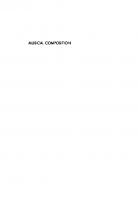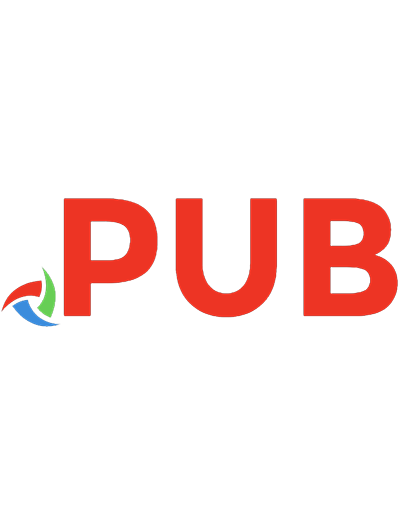Classification of Musical Objects for Analysis and Composition 9783031301827, 9783031301834
158 33 6MB
English Pages 156 Year 2023
Table of contents :
Preface
Contents
Part I Initial Orientation
1 The Basic Problem of Classification
1.1 Structures
1.2 Relationships
1.3 The Overall Challenge
Part II General Formal Concepts
2 Ontology, Oniontology, and Creativity
2.1 Ontology and Oniontology
2.2 Ontology: Where, Why, and How
2.3 Oniontology: Facts, Processes, and Gestures
2.4 A Short Characterization
2.5 Oniontology for Classification
2.6 Creativity
3 Formal Representation of Musical Structures
3.1 Scientific vs. Creative Value of Classification
3.2 Software-oriented Perspectives
4 Denotators over General Categories
4.1 Formal Definition of Forms
4.2 Formal Definition of Denotators
4.3 The Category of Denotators
4.4 First Examples of Denotators in Theory and Practice
4.4.1 First Examples of Denotators
4.4.1.1 Denotators over the Category Mod
4.4.1.2 Denotators over the Category Digraph
4.4.2 Hyperdenotators
4.4.2.1 Hyperdenotators over the Category Mod
4.4.2.2 Hyperdenotators over the Category Digraph
4.4.3 Gestures over Topological Categories
5 Composition Denotators and Classification
5.1 Some Classical Composition Denotators
5.2 The Role of Classification in Tonal Modulation Theory
5.3 Modulations in Beethoven’s op. 106
6 Gestural Denotators: A First Overview
6.1 The Symmetric Concept Architecture between Compositions and Gestures
6.2 The Role of Yoneda’s Lemma
6.3 Software Perspectives
7 The Escher Theorem for Compositions and Gestures
7.1 The Escher Theorem and Escher Categories
7.1.1 First Examples
Part III Local Classification
8 Local Composition and Gesture Classification
8.1 Classification of Local Compositions
8.1.1 Compositions as Sequences of Module Elements
8.1.2 Eliminating Diagonal Elements
8.1.3 Transforming Sequences to Linear Maps
8.1.4 The Grassmann Scheme for Local Compositions
8.2 Classification Problems for Local Gestures
9 Classification of Chords
10 Motif Classes
10.1 Three Element Motives in Analysis
10.1.1 An Example from Classical Music
10.2 Three Element Motives and an Example of a Melody from this Repertory in the Jazz Composition Synthesis
10.3 A General Algorithm for the Construction of Generic Melodies Composed by Motives of n Elements Each
10.4 Calculation of the Classes of n-element Motives in Z2 12
11 Third Chain Classes
12 Harmony through Third Chains
13 Counterpoint Worlds
14 Strong Interval Dichotomies
15 Microtonal Contrapuntal Theories
15.1 The Category of Strong Dichotomies
15.2 Towers of Strong Dichotomies
16 Dodecaphonic Rows
Part IV Global Classification
17 Global Composition and Gesture Classification
17.1 Why Global Compositions and Gestures
17.1.1 Global Compositions
17.1.1.1 Boulez and Webern
17.1.1.2 Uhde/Wieland and Marek
17.1.1.3 Hoffmann and Kaiser
17.1.1.4 Graeser, Ruwet, and Nattiez
17.1.1.5 Jackendoff and Lerdahl
17.1.1.6 Schaeffer and Cage
17.1.1.7 Musical and Mathematical Manifolds
17.1.1.8 Global Gestures
17.1.1.9 The Definition of Global Compositions and Global Gestures
17.1.1.10 Examples of Global Compositions and Gestures
17.1.2 The Nerve of a Global Composition or Gesture
17.2 Classification through Modules of Affine Functions
17.2.1 Local Compositions and Functions
17.2.2 Morphisms and Function Spaces
17.2.3 Global Standard Structures and Resolutions for Compositions
18 The Classification Theorem for Global Compositions
18.1 Preliminary Remarks
18.1.1 Characterization of Interpretations
18.1.2 An Example of a Non-interpretable Global Composition
18.2 The Musical Meaning of Non-Interpretable Compositions: Varèse’s Program and Yoneda’s Lemma
18.2.1 Global Dodecaphonic Classes
18.3 Classification of Global Compositions
18.3.1 The Resolution of a Global Composition
19 The Classification Problem of Global Gestures
19.1 Local Gesture and Functions
19.1.1 Restriction of Gesture Types
19.1.2 Global Standard Structures and Resolutions for Gestures
19.2 A Conjectured Classification Theorem
19.2.1 A Hypergesture for Human Bodies
20 Singular Homology of Hypergestures
20.1 Homology via Hypergestures
20.2 Homology and Counterpoint
21 Local Gestures, Structures of Knots, and Local Gestures as Local Compositions
21.1 Local Gestures and Knot Theory
21.2 Local Gestures as Local Compositions
21.2.1 Characterstic Differences
21.2.2 Conclusion and Future Topics
Part V Classification and Creativity
22 Gestural Interpretation of Harmonic Dynamics in Tonal Modulation and Future Developments
22.1 Gestural Modulation and Creativity
22.2 Classification Problems for Performance Gestures
22.3 Mirror Logic
22.3.1 Introduction
22.3.2 The Logic of Spatial Mirrors
22.3.3 Temporal Specification of Chords
22.3.4 Construction of First Species Counterpoint
22.3.4.1 Hypergestures for Counterpoint Summary.
22.3.5 Lead Sheet in Jazz
22.3.6 Dance Gestures Associated with Musical Structures
22.3.7 Conclusion and Future Topics
22.4 Perspectives of Future Theory
Part VI References, Index
23 Classification Lists
23.1 List of Local Denotators in Z12, Chord Classes
23.2 Third Chain Classes
23.3 List of Local Denotators of Cardinality Two and Three in Z2 12
23.3.1 Two Tone Motifs in Z2 12
23.3.2 Two Tone Motifs in Z5 × Z2 12
23.3.3 Three Tone Motifs in Z2 12
23.4 List of Local Denotators of Cardinality Four in Z2 12
23.5 List of Modulation Chords (Pivots)
References
Index




![Fundamentals of Musical Composition [1, 1 ed.]
0571092764](https://dokumen.pub/img/200x200/fundamentals-of-musical-composition-1-1nbsped-0571092764.jpg)



![Musical Portraits: The Composition of Identity in Contemporary and Experimental Music [Illustrated]
0190653507, 9780190653507](https://dokumen.pub/img/200x200/musical-portraits-the-composition-of-identity-in-contemporary-and-experimental-music-illustrated-0190653507-9780190653507.jpg)

